 Frederico Füllgraf, Santiago de Chile, for Mundus maris
Frederico Füllgraf, Santiago de Chile, for Mundus maris
With its 4,000 kilometers of coastline, Chile is, ahead of Japan, the sixth largest fishing industry in the world, but the world's third largest producer of farmed salmon. The industrially guided salmon farming is concentrated on the coast of Chilean Patagonia with an area of 19,893 hectares of marine concessions from the state and annual sales of 2.0 billion Euros. Ever since 2008, salmon farming in Chile is, however, in the crossfire of criticism.
The government is accused of undue tolerance in relation to the industry's circumvention of the already lax environmental laws; transnational corporations are criticized for unecological management, incl. the systematic pollution of the southern Chilean Sea with viruses, hormones and industrial waste - a scenario for much needed intervention that contradicts the sustainability proclaimed and which was completely concealed at the maritime conference "Our Ocean" in October 2015 and now culminating in the recent environmental disaster of Chiloé.
After several years of residence in Chile - first as development worker, later as a journalist - Wilfried Huisman became aware of the salmon farming economy in Chilean Patagonia and turned the 2010 premiered television documentary "Salmon Fever".
 In the very first minute of film, the audience is confronted with contrasting images shifting between a Patagonian summer idyll and underwater farms in Chile where up to 200,000 salmon can be crammed together in a single cage - twice the permitted stocking rate in Europe.
In the very first minute of film, the audience is confronted with contrasting images shifting between a Patagonian summer idyll and underwater farms in Chile where up to 200,000 salmon can be crammed together in a single cage - twice the permitted stocking rate in Europe.
Next we see low-light images of a diver scanning ahead with his hands on the muddy seabed in southern Chile glancing through turbid water. We listen to the comment of Chilean professional diver Cristian Soto: "Torn fishnets, rubber hoses, batteries, tires ..." - tons of industrial waste with food remnants and faeces of farmed fish form a highly toxic mixture "that kills the marine flora and fauna" warns Soto.
The "Big Wolf"
At the time, Soto was employed by the Norwegian Firm “Marine Harvest”, owned by Norwegian John Frederiksen, known as “the Big Wolf”. With his private wealth estimated at about 9,0 billion Euro, he is on rank 133 of Forbes-Ranking 2016 of the richest people on Earth.
“His empire is the sea. he owns ships, oil platforms and salmon farms”, says the sound track of the film.
But even a cursory additional research on Frederiksen on the internet reveals a colourful figure e.g. in dealing with rights and obligations, see: It seems for tax reasons, he fled in the early 1990s from his native Norway, initially adopting a Cypriot passport, later moving to London where the City is closely intertwined with international tax havens. As an ice-cold manager he succeeded for example in 2014 to circumvent the sanctions against Russia and negotiate a billion-euro deal between his company Seadrill and the oil giant Rosneft.
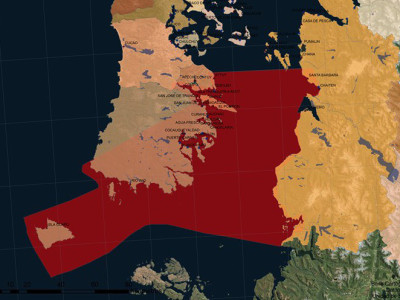
As owner of the Chilean "Marine Harvest" Frederiksen has the largest salmon farm in South America. One hundred million salmon (100,000,000) are fattened for worldwide export year after year.
The slow death on the seabed
Since Soto's warnings seven years had passed, when in May 2016 the most threatening environmental bombs of recent Chilean history exploded on the coast of the Patagonian island of Chiloé: Wide into the open sea a so-called "red tide" (marea roja) of toxic algae extended over many kilometers and led to the mass extinction of fish, crab and other shellfish species. The result was desperation among the thousands of small commercial fishers.
The disaster had the following history.
On March 4, 2016 the Directorate General for Territorial Waters and the Merchant Marine (Directemar) of the Chilean Navy had authorised the Association of Chilean Salmon Industries (Asociación de la Industria del Salmón de Chile AG - abbreviated SalmonChile) the dumping of 9,000 tons of dead farmed salmon into the Pacific, just in front of the coast of the Lake District (Región de Los Lagos) in southern Chilean Patagonia.
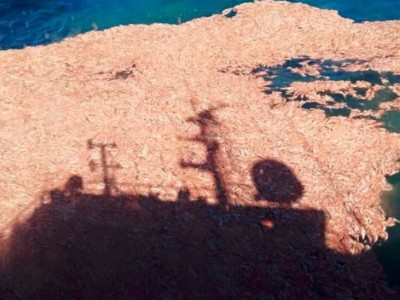 The background: The request of SalmonChile took place after a mass extinction by suffocation of about 40,000 tons of farmed salmon, 2016. February 22 SalmónChile hastened to explain the catastrophy with "adverse climatic and oceanographic conditions" at the mouth of Reloncavi stream in Región de Los Lagos.
The background: The request of SalmonChile took place after a mass extinction by suffocation of about 40,000 tons of farmed salmon, 2016. February 22 SalmónChile hastened to explain the catastrophy with "adverse climatic and oceanographic conditions" at the mouth of Reloncavi stream in Región de Los Lagos.
The State Service for Fisheries and Aquaculture (Sernapesca) then issued an emergency plan.
As a result of tough negotiations with SalmonChile, the government ordered to deliver half of the dead salmon mass to the fish meal industry and to dispose of one third on land. After exploiting all opportunities for processing and disposal there were still several thousand tons of dead salmon left. So SalmonChile requested Directemar on March 3 to be allowed to discharge the remaining 11,600 tons of dead salmon into the open sea. The Navy Directorate demanded a technical opinion of Sernapesca. On March 4, the Authority approved the disposal at sea, on the grounds that the dead salmon "would not damage the oceanic ecosystem, neigher jeopardise human life at sea, the sea routes, or the activities of other marine users".
Said and done: On the same day the Navy allowed SalmonChile the dumping of supposedly "only" 4,655 tons of dead farmed salmon in Chilean waters off the island of Chiloé. The quantity figure is controversial, other estimates - one by the environmental organisation Terram - mentioned up to 15,000 tons.
The entire maneuver - the mass death, the negotiations and the 11 disposal trips with dead salmon to the open sea - was concealed from the public - especially the small-scale fishing communities.
S.O.S. Chiloé
Two months later, the coastal waters in front of Chiloé were haunted by the "red tide" of toxic algae.
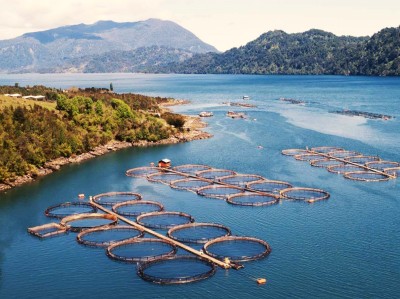 The initial diagnosis of independent scientists: The suffocation of the fish is the result of explosive algal growth, because the algae can not be grazed upon fast enough by small planktonic animals (zooplankton), thus sinking to the sea bottom. There the algae are broken down by bacteria, which consume all the oxygen in the water in that process and jeopardise or even kill all other life.
The initial diagnosis of independent scientists: The suffocation of the fish is the result of explosive algal growth, because the algae can not be grazed upon fast enough by small planktonic animals (zooplankton), thus sinking to the sea bottom. There the algae are broken down by bacteria, which consume all the oxygen in the water in that process and jeopardise or even kill all other life.
The algal bloom itself is a symptom of overfertilisation (eutrophication). As more than half the fish meal distributed across the net cages is not eaten in time by the salmon and sinks to be sea bottom below, it leads to an accumulation of excess feed for plants and bacteria. This creates, among others, anoxic conditions, that is lack of oxygen, which in turn provokes massive deaths of many organismens.
A propos fish meal: The transnational salmon fattening industry uses the valuable South Pacific horse mackerel (Trachurus murphyi) as feed in its salmon farms. Here it reveals the madness from the perspective of food ecological and – economical - practice: 5 kg of horse mackerel meal for the production of 1 kg if salmon. The Chilean daily La Nación warned as early as end 2010 against impending overfishing and commercial extinction of horse mackerel ("Sobreexplotación extingue al Jurel", 28.11.2010). Nota bene, the horse mackerel is an excellent food item for direct human consumption.
The disaster at the surface
On 28 April 2016 the Chilean Navy announced the ecological emergency: In front of the beaches of Playa Grande de Cucao, Huentemó and Chanquín, of the Chiloé-archipelago, red tides drifted in up to five km broad bands. At their frontiers, dead shrimps, crabs and other shellfish as first indicator of the poisoning.
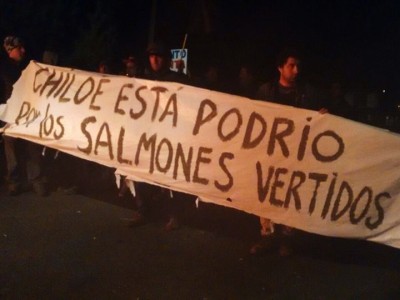 The mass media started addressing the issue only after the central government in Santiago had declared the Patagonian Sea a disaster zone on 30 April. The daily La Tercera first reported "500 affected families", which were to receive a laughable compensation equivalent to about 140 Euro from the government of Michelle Bachelet. Following a tough statement by the mayor of Chonchi, Pedro Andrade, the government and the media admitted that the disaster had affected several thousand people depending on artisanal fisheries already since a month.
The mass media started addressing the issue only after the central government in Santiago had declared the Patagonian Sea a disaster zone on 30 April. The daily La Tercera first reported "500 affected families", which were to receive a laughable compensation equivalent to about 140 Euro from the government of Michelle Bachelet. Following a tough statement by the mayor of Chonchi, Pedro Andrade, the government and the media admitted that the disaster had affected several thousand people depending on artisanal fisheries already since a month.
This is why mass protests with barricades and tires on fire set in on Chiloé. Across the country people showed solidarity reaching even to the Moneda, seat of the government in Santiago.
Salmon fattening, a menace for the marine environment and life
Experts and government were visibly reluctant to offer explanations for the causes. The professional association of marine biologists Chile (Colegio de Biólogos Marinos) went so far as to claim that there was "no connection" between the mass killing, or the dumping of salmon in the sea, and the red tide.
 Conversely, Dr. Bernd Krock, scientist at the Alfred Wegener Institut for Polar and Marine Research (AWI), Bremerhaven, Germany, declared end May to Deutsche Welle, that so-called "red tides" never arise without a superposition of natural and anthropogenic factors. Changes in the climate, like the increase in seawater temperature, explain only part of the disaster. Their overvaluation neglects considering two further aspects: first, the excessive use of the Chilean fjords for salmon culture, second, excessive feeding of salmon in order to accelerate fattening, which in turn stimulates algal blooms, including those of dangerous organisms.
Conversely, Dr. Bernd Krock, scientist at the Alfred Wegener Institut for Polar and Marine Research (AWI), Bremerhaven, Germany, declared end May to Deutsche Welle, that so-called "red tides" never arise without a superposition of natural and anthropogenic factors. Changes in the climate, like the increase in seawater temperature, explain only part of the disaster. Their overvaluation neglects considering two further aspects: first, the excessive use of the Chilean fjords for salmon culture, second, excessive feeding of salmon in order to accelerate fattening, which in turn stimulates algal blooms, including those of dangerous organisms.
"Chile's government wants to promote the operation of new industries, but is reluctant to take measures that could allegedly affect the economy. On the other hand, it showers the country continuously with environmental problems, which exceed by far what is tolerable," Krock points out.
Juan Carlos Cárdenas, a veterinarian of the NGO Ecoceanos Chile, confirms Krock's diagnosis, but lists additional facts and is more critical towards the salmon industry:
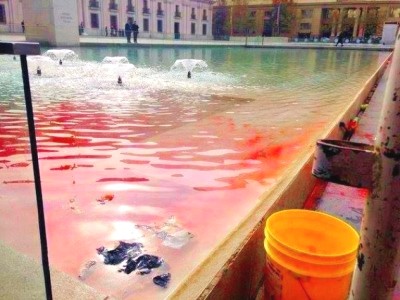 "The current crisis in Chiloé is the result of continuous expansion of areas over the last 25 years and unregulated production modes of the mega salmon industries which are based on maximum exploitation until depletion. Their business model blatantly disregards the carrying capacity of fragile local ecosystems. The overboarding organic overload through excessive use of fish feeds and accumulation of faeces generates severe eutrophication, which charges the marine environment with extremely high concentrations of phosphorous and nitrogen, which trigger the explosive algal blooms in ever accelerating ways. For every ton of fattened salmon the marine environment receives 72 kg of nitrogen per year. That is equivalent to the nitrogen release of 19.000 people.
"The current crisis in Chiloé is the result of continuous expansion of areas over the last 25 years and unregulated production modes of the mega salmon industries which are based on maximum exploitation until depletion. Their business model blatantly disregards the carrying capacity of fragile local ecosystems. The overboarding organic overload through excessive use of fish feeds and accumulation of faeces generates severe eutrophication, which charges the marine environment with extremely high concentrations of phosphorous and nitrogen, which trigger the explosive algal blooms in ever accelerating ways. For every ton of fattened salmon the marine environment receives 72 kg of nitrogen per year. That is equivalent to the nitrogen release of 19.000 people.
The entire Chilean coast is under extreme threat. The red tides are no longer confined to the fjords and canals leading to inland waters. They extend along the coasts and even reach the high seas. They are a threat for public health, biodiversity and the work and life of Chilean coastal communities warns the marine activist.
Epilog
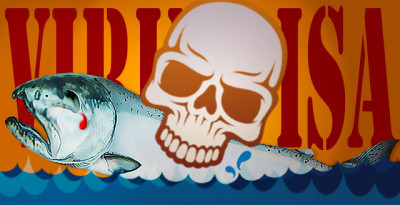 What Huismann's "Salmon Fever" film-epilog only alludes to, the film maker explained to me in greater detail on a personal basis. The filming crew negotiated for months with “Marine Harvest” to obtain an interview with John Frederiksen – in vain. “The Big Wolf” answers no questions.
What Huismann's "Salmon Fever" film-epilog only alludes to, the film maker explained to me in greater detail on a personal basis. The filming crew negotiated for months with “Marine Harvest” to obtain an interview with John Frederiksen – in vain. “The Big Wolf” answers no questions.
This is how it remained until the last shots of the film – when he was intercepted by the camera crew at the entrance of a restaurant - he refused to answer the question how the ISA-Virus reached Chile -the causative agent of the "infectious salmon anemia", which has contaminated the Patagonian coast with its river delta at the beginning of the new millennium .
Frederiksen's lapidary, cynical answer: "I have nothing to do with the decisions on the spot."








